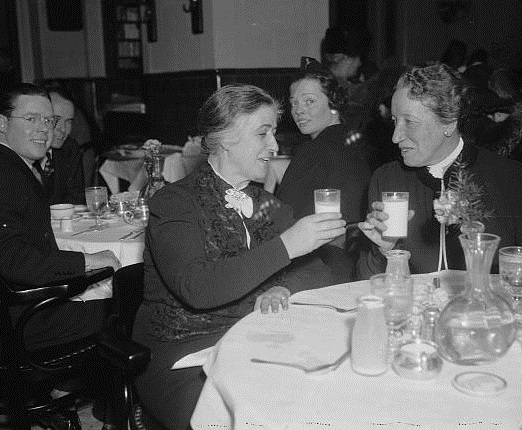Caroline Goodwin was born on a Georgia plantation in 1875 but spent years working for progressive causes, including woman suffrage and world peace. She had gone to Europe to study art, and there she met Daniel O’Day, with whom she moved to New York after they married. In fact, it was Daniel who first asked Caroline why she was watching a suffrage parade with him rather than marching in it. After joining the League of Women Voters, O’Day met Eleanor Roosevelt and later began working with New York City settlement houses and the Women’s International League for Peace and Freedom.
O’Day held several state and Democratic Party appointments in New York before joining the 1934 race for two at-large U.S. House seats. Eleanor Roosevelt, by then First Lady, campaigned for her friend and even chaired her campaign committee. It was the first time a First Lady actively campaigned for any congressional candidate; Roosevelt said she was “justified” because the campaign was in her own state. O’Day won the largest share of the votes in the election and went on to serve four terms in the House. For the last three terms, she chaired the Committee on Election of President, Vice President, and Representatives in Congress.

O’Day worked passionately for world peace; she also advocated New Deal programs that supported labor and children as well as the various arts programs under the Works Progress Administration. She also invested in civil rights causes, including supporting 1935 and 1937 antilynching bills and opposing detention camps for aliens in the years leading into WWII. During those years, O’Day opposed Roosevelt administration actions that presaged US involvement in the war, but Nazi treatment of Jews and minorities and the Japanese attack on Pearl Harbor led her to shift her position. While ill health kept her from Congress when it voted to declare war on Japan, she told colleagues she would have voted for the war resolution.
That poor health prevented O’Day from running for reelection in 1942, and her final term in Congress ended on January 3, 1943. She died the next day in New York.
Sources:
Biographical Directory of the United States Congress
Wasniewski, Matthew, editor in chief, Women in Congress, 1917-2006 (2006), pp. 155-157.

I really enjoyed this brief write-up of Representative Caroline O’Day. The first woman elected to Congress from a large-constituent district, she is a wonderful example of the rich tradition of the U.S. Capitol as a place of political change. Her association with Franklin and Eleanor Roosevelt, and emphatic effort to advance women in politics, resonates well in our time when historical memory is often forgotten. Readers seeking more information would be well served to read Paul Hicks’ tribute to her that was published in the Summer 2007 issue of New York History (Volume 88, No 3), pp. 287-305.
Thanks, Ron! I literally let the reference book fall open and discovered yet another fascinating story of an unknown-to-me Member of Congress. The Women in Congress book is a treasure trove of these stories.